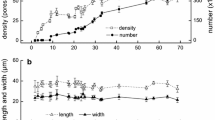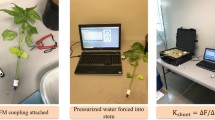Summary
Leaf stomatal resistance varies considerably in response to changes in environmental conditions. Understanding cultivar differences in the response of stomata to these conditions is important for effectively simulating water-use and growth.
In this study the stomatal resistance of three field grown potato (Solanum tuberosum L.) cultivars Atlantic. Monona and Norchip was observed in response to photosynthetic photon flux density, leaf to air vapour pressure difference and root zone available soil water. Substantial variation in stomatal resistance was accounted for by functions of the environmental variables for both Monona and Norchip. The explained variation for Atlantic was considerably less. Light saturation occurred near 500 μmol m−2 s−1. Increasing stomatal resistance above 1000 μmol m−2s−1 was also observed but is likely an artifact of stomatal closure on days in which mid-day leaf water potentials dropped below critical levels. Although the leaf presumably insufficient to obtain substantial effects. The soil water status was partially linked to the average 1000 h to 1500 h stomatal resistance on clear, sunny days. Significant differences were observed among the cultivars in the response of stomata to changes in the available soil water.
Similar content being viewed by others
References
Akita, S. & D.N. Moss. 1972. Differential stomatal response between C3 and C4 species to atmospheric CO2 concentration and light.Crop Science 12: 525–533.
Clawson, K.L., B.L. Blad & J.E. Specht, 1986. Use of portable rainout shelters to induce water stress.Agronomy Journal 78: 120–123.
Coffey, W.L.P., 1989. The Morpho-Physiological Response of Three Cultivars of Potato (Solanum tuberosum L.) to Varying Levels of Drought Stress. M.Sc. Thesis. University of Guelph, Guelph. Ontario, 121 pp.
Dwelle, R.B., P.J. Hurley & J.J. Pavek. 1983. Photosynthesis and stomatal conductance of potato clones (Solanum tuberosum L.).Plant Physiology 72: 172–176.
Dwelle, R.B., G.E. Kleinkopf & J.J. Pavek, 1981. Stomatal conductance and gross photosynthesis of potato (Solanum tuberosum L.) as influenced by irradiance, temperature, and growth stage.Potato Research 24: 49–59.
Epstein, E. & W.J. Grant. 1973. Water stress relations of the potato plant under field conditions.Agronomy Journal 65: 400–404.
Gandar, P.W. & C.B. Tanner, 1976. Potato leaf and tuber water potential measurements with a pressure chamber.American Potato Journal 53: 1–14.
Jarvis, P.G., 1976. The interpretation of the variations in leaf water potential and stomatal conductance found in canopies in the field.Philosophical Transcactions of the Royal Society of London, 273: 593–610.
Kaufmann, M.R., 1982. Leaf conductance as a function of photosynthetic photon flux density and absolute humidity difference from leaf to air.Plant Physiology 69: 1018–1022.
Kim, J. & S.B. Verma, 1991. Modelling canopy stomatal conductance in a temperate grassland ecosystem.Agricultural Forest Meteorology 55: 149–166.
Ku, S.B., G.E. Edwards & C.B. Tanner, 1977. Effects of light, carbon dioxide and temperature on photosynthesis, oxygen inhibition of photosynthesis and transpiration inSolanum tuberosum.Plant Physiology 59: 868–872.
Levy, D., 1983. Varietal differences in the response of potatoes to repeated short periods of water stress in hot climates. 1. Turgor maintenance and stomatal behaviour.Potato Research 26: 303–313.
Manhas, J.S. & N.P. Sukumaran, 1988. Diurnal changes in net photosynthesis rate in potato in two environments.Potato Research 31: 375–378.
McDermitt, D.K., 1990. Sources of error in the estimation of stomatal conductance and transpiration from porometer data.Hort Science 25: 1538–1548.
Monteith, J.L., 1975. Principles of Environmental Physics. Edward Arnold Publishers Ltd., London, 241 pp.
Norman, J., 1983. Modelling the complete crop canopy. In: Modification of the Aerial Environment of Crops. ASAE, St. Josephs. Michigan, 538 pp.
Petersen, K.L., S. Moreshet & M. Fuchs, 1991. Stomatal responses of field-grown cotton to radiation and soil moisture.Agronomy Journal 83: 1059–1065.
Raschke, K., 1979. Movements using turgor mechanisms. In: W. Haupt & M.E. Feinleib (Eds). Physiology of movements, encyclopedia of plant physiology. Springer-Verlag, Berlin, pp. 383–441.
Rijtema, P.E. & A. Aboukhaled, 1973. Crop water use in the Arab Republic of Egypt. FAO Report. RNEA. Cairo, pp. 56.
SAS Institute Inc., 1985. SAS user's guide: Statistics, Version 5 edition. SAS Institute, Cary, NC, 956 pp.
Singh, G., D.M. Brown & A.G. Barr, 1993. Modelling soil water status for irrigation scheduling in potatoes I. Description and sensitivity analysis.Agricultural Water Management 23: 329–341.
Stark, J.C., 1987. Stomatal behavior of potatoes under non-limiting soil water conditions.American Potato Journal 64: 301–309.
Thompson, N., I.A. Barrie & M. Ayles. 1981. The Meteorological Office Rainfall and Evaporation Calculation System: MORECS (July 1981). British Meteorol. Office Hydrological Memorandum No. 45, 73 pp
Topp, G.C., J.L. Davis & A.P. Annan, 1980. Electromagnetic determination of soil water content: Measurements in coaxial transmission lines.Water Resources Research 16: 574–582.
Turner, N.C., 1974. Stomatal response to light and water under field conditions. In: R.L. Bieleski, A.R. Ferguson & M.M. Cresswell (Eds). Mechanisms of Regulation of Plant Growth.Bulletin of the Royal Society of New Zealand 12: 423–432.
Turner, N.C., 1991. Measurement and influence of environmental and plant factors on stomatal conductance in the field.Agricultural Forest Meteorology 54: 137–154.
Turner, N.C. & G.H. Heichel, 1977. Stomatal development and seasonal changes in diffusive resistance of primary and regrowth foliage of red oak (Quercus rubra L.) and red maple (Acer rubrum L.).New Phytology 78: 71–81.
Vos, J. & P.J. Oyarzun, 1987. Photosynthesis and stomatal conductance of potato leaveseffects of leaf age, irradiance and leaf water potential.Photosynthesis Research 11: 253–264.
Young, E., J.M. Hand & S.C. Wiest, 1981. Diurnal variation in water potential components and stomatal resistance of irrigated peach seedlings.Journal of the American Society of Horticulture Science 106: 337–340.
Zaag, D.E. van der & W.G. Burton, 1978. Potential yield of the potato crop and its limitations. In: Survey Papers, 7th Triennial Conference of the European Association for Potato Research, Warsaw, pp. 7–22.
Zelitch, I., 1961. Biochemical control of stomata opening in leaves.Proceedings of the National Academy of Science USA 47: 1423–1433.
Author information
Authors and Affiliations
Rights and permissions
About this article
Cite this article
Gordon, R.J., Brown, D.M. & Dixon, M.A. Stomatal resistance of three potato cultivars as influenced by soil water status, humidity and irradiance. Potato Res 40, 47–57 (1997). https://doi.org/10.1007/BF02407561
Accepted:
Issue Date:
DOI: https://doi.org/10.1007/BF02407561




